Transport yourself to a tropical shore with this Gluten-Free Pineapple Upside Down Cake! Boasting a rich and caramelized pineapple topping and a moist and delicate crumb, this recipe will leave even your gluten-eating friends begging for more!
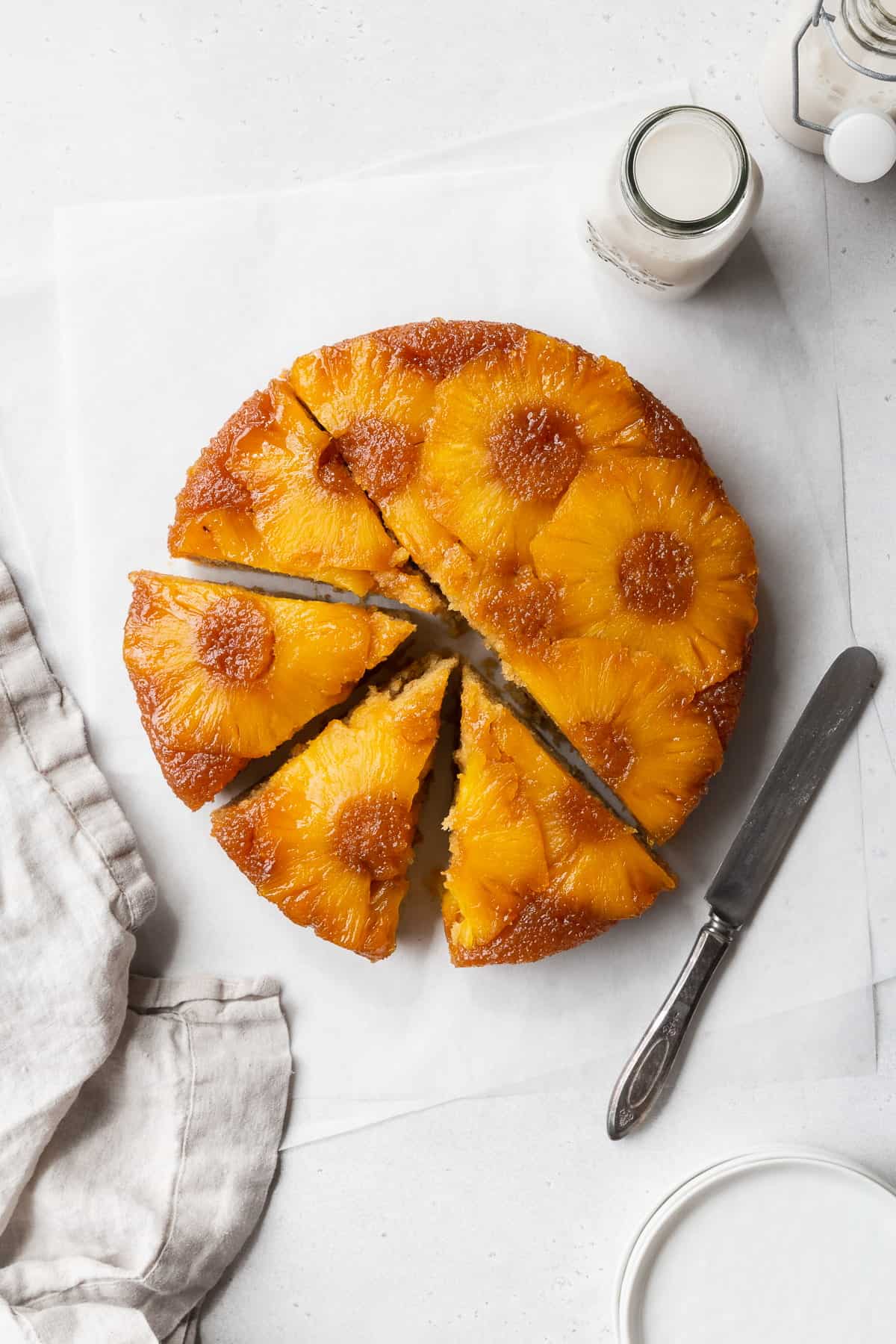
Table of contents
Just one bite of this gluten-free pineapple upside down cake and you'll be whisked away to the first day of vacation. The sweet and golden flavor evaporates your worries and lets you settle into the lighthearted and refreshing times ahead. That first taste is so captivatingly delicious that it zones you in on just the delight of the amber dessert in front of you.
Usher vacation onto your dessert table today with a dessert that, though it wields the power to transport you to summer vacation paradise, is accessible and easy enough to make regardless of your responsibilities in the here and now.
Best of all, upside down pineapple cake is gluten-free and made with fresh pineapple, instead of canned. It's lighter on your digestion though still huge on classic pineapple upside down cake flavor. Maybe we get to enjoy a true few moments of vacation after all.
If you're looking for more craveable and delicious gluten-free desserts, check out my gluten-free pound cake, gluten-free coffee cake, gluten-free lemon poppy seed cake, and gluten-free chocolate marshmallow cookies.
Why You'll Love Gluten-Free Upside Down Pineapple Cake
- Soft and Moist Sponge. Brown sugar and butter lace through the pineapple glaze layer, contributing moisture, sweetness, and flavor to the sponge.
- Sweet and Bright Pineapple. There's nothing quite like the soft, golden, and sunshiny flavor of pineapple upside down cake. Just because you're not eating gluten doesn't mean you can't enjoy it, too!
- Allergy-Friendly. No gluten? No problem! This pineapple cake is a gluten-free triumph!
- Straight Forward Prep. Though this recipe does call for a few steps, none are complicated or involved. I also give you all the tips to keep your pineapple cake from falling apart.
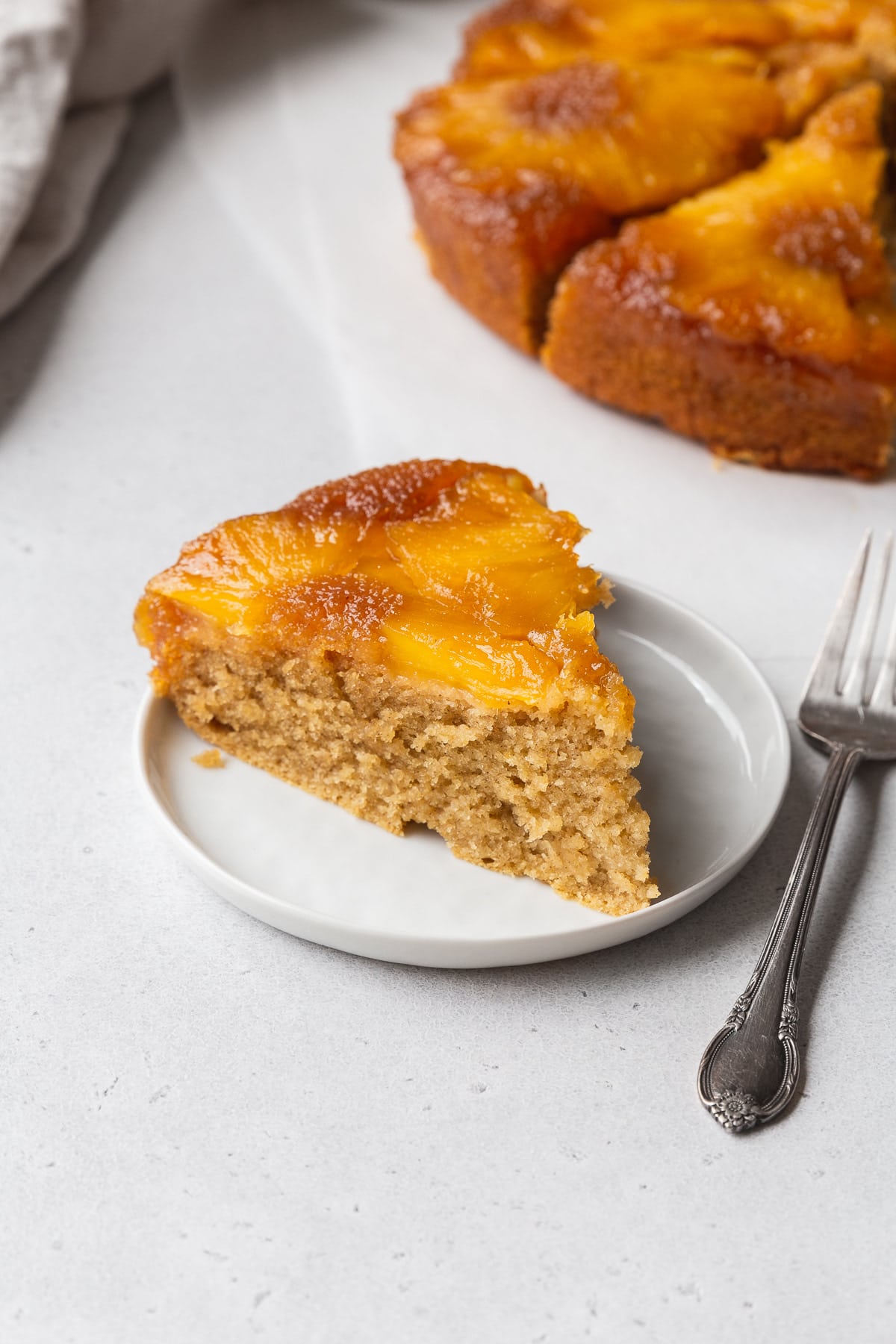
Ingredients
Gluten-free upside down pineapple cake calls for a handful of ingredients, though all of them are easily found at well-stocked grocery stores.
Pineapple Layer Ingredients
- Small Pineapple - Peel, core, and sliced into ½-inch rings. You also will want to reserve 2 tablespoons of the pineapple juices from the cutting board.
- Light Brown Sugar - Packed well to measure.
- Butter - Cooks down with the pineapple and brown sugar, making the pineapple layer rich and buttery.
- Salt - Enhances the sweetness of the pineapple-brown sugar layer.
Additional Cake Ingredients
- 1-to-1 Gluten-Free Flour - Choose a blend that contains xantham gum, like Bob's Red Mill's 1-to-1 Gluten-Free Flour or King Arthur's Measure-for-Measure Gluten-Free Flour.
- Cornstarch - Mixes with the gluten-free flour blend to create gluten-free cake flour.
- Sugar - Sweetens the gluten-free pineapple dessert just perfectly.
- Large Eggs - Give the cake structure and richness.
- Vanilla Extract - Use pure vanilla extract for the best flavor.
- Sour Cream - Tenderizes the cake crumb, making it moist and buttery.
- Whole Milk - The higher fat content of this milk adds richness and flavor to the cake.
- Spices - Ground cinnamon and ground cardamom.
- Baking Soda & Baking Powder - These leavening agents help the sponge rise, giving it a springy loft.
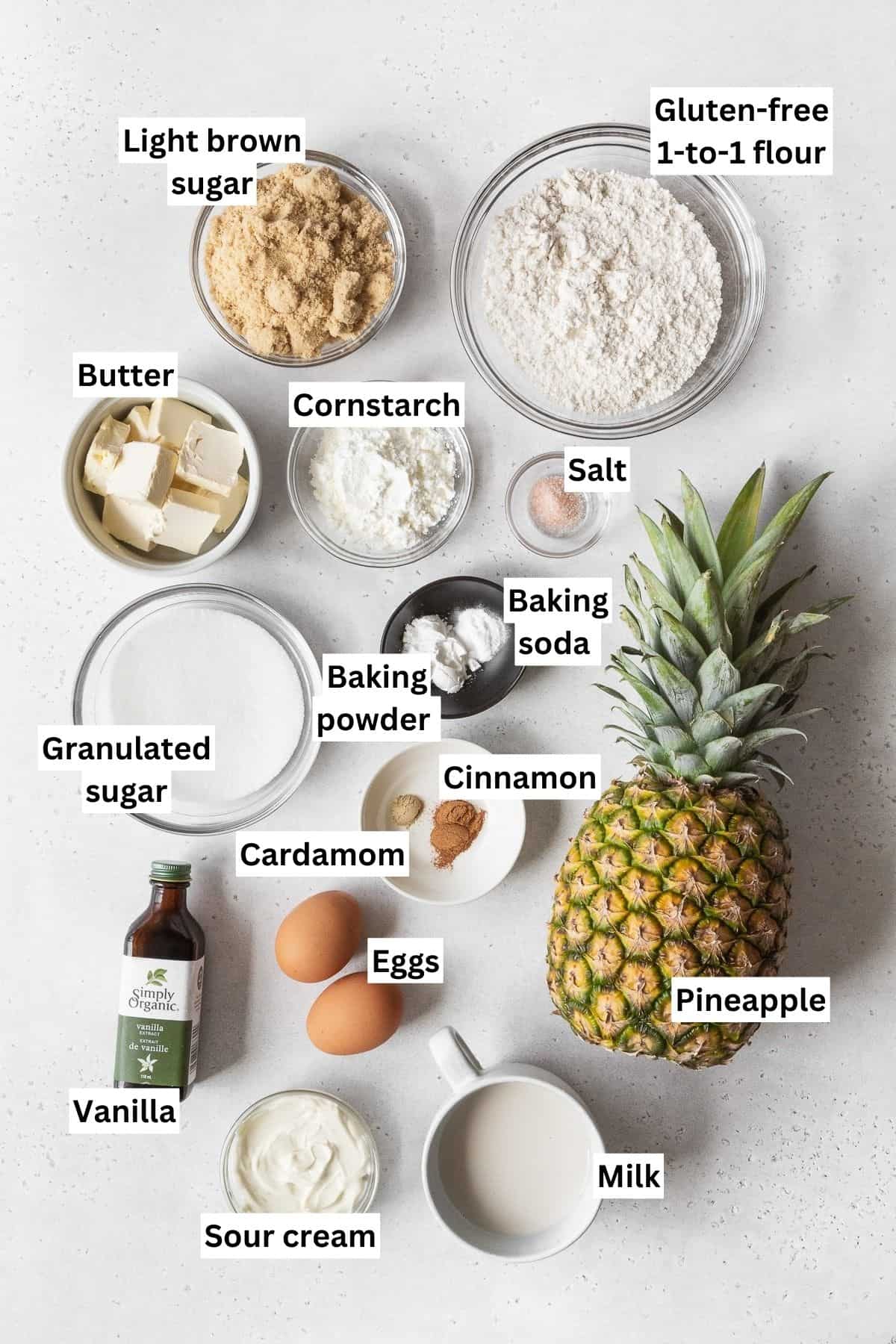
How to Make Gluten-Free Pineapple Upside Down Cake
Make your next pineapple upside down cake gluten-free by following these straightforward recipe steps!
Step 1: Peel, core, and slice the pineapple into ½-inch thick rings. You'll need 6-7 slices. Reserve two tablespoons of the pineapple juice from the cutting board or, using a citrus press, squeeze juice from an extra pineapple slice.
Step 2: Add the butter, light brown sugar, salt, and pineapple juice to a skillet. Cook it over medium heat while stirring occasionally, or until it thickens slightly.
Step 3: Add the pineapple slices to the brown sugar mixture and cook for 10 minutes, flipping the pineapple halfway through. Take the skillet off the heat.
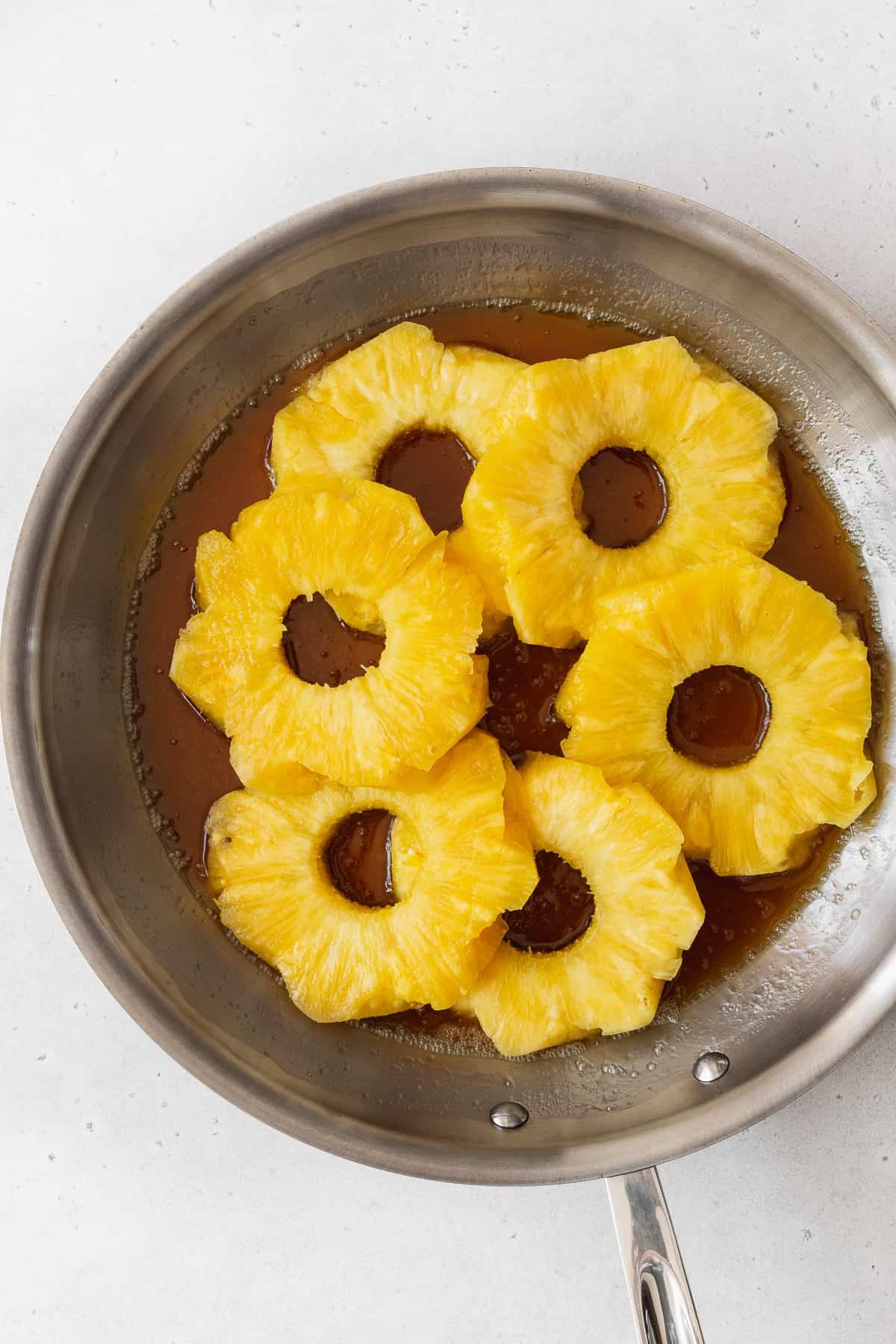
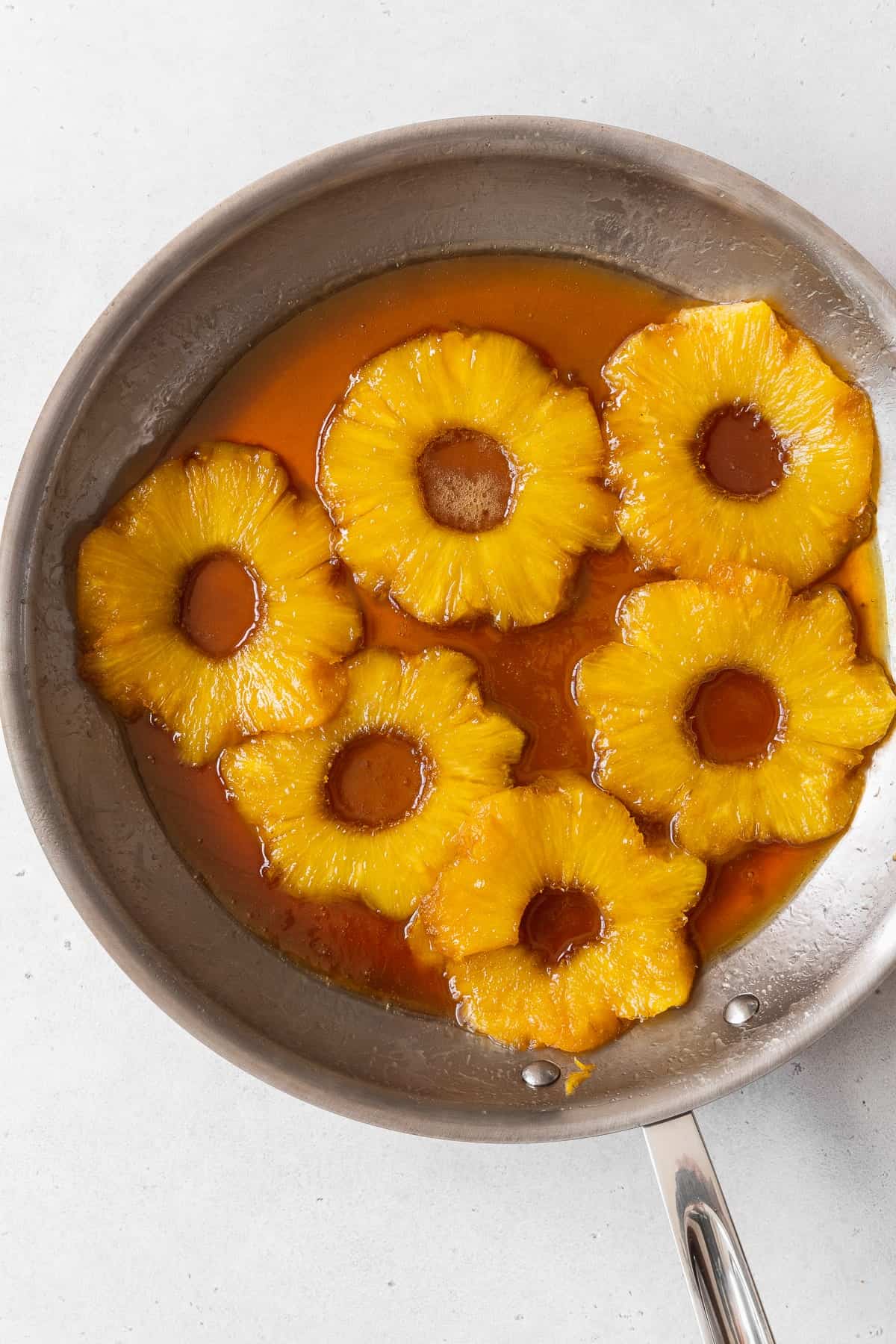
Step 4: In a bowl, whisk together the gluten-free flour, cornstarch, salt, baking soda, baking powder, cinnamon, cardamom, and granulated sugar until combined.
Step 5: Add the softened butter to the dry ingredients and, using your fingers or a pastry cutter, work the butter into the flour mixture until the mixture resembles coarse sand.


Step 6: In a separate bowl, whisk the eggs, sour cream, and vanilla together until combined. Add the wet mixture to the dry ingredient mixture and whisk to combine.


Step 7: While continuing to mix the batter, slowly pour in the milk until smooth and pourable. Cover the mixing bowl and let the batter rest for 30 minutes.


Step 8: Preheat the oven to 350°F (177°C) and grease the sides of a 9-inch round pan.
Step 9: Arrange the pineapple slices in the bottom of the pan. Pour all of the syrup on top. Carefully pour the cake batter over the pineapple, making sure not to move around the pineapple as you do. Smooth out the surface.
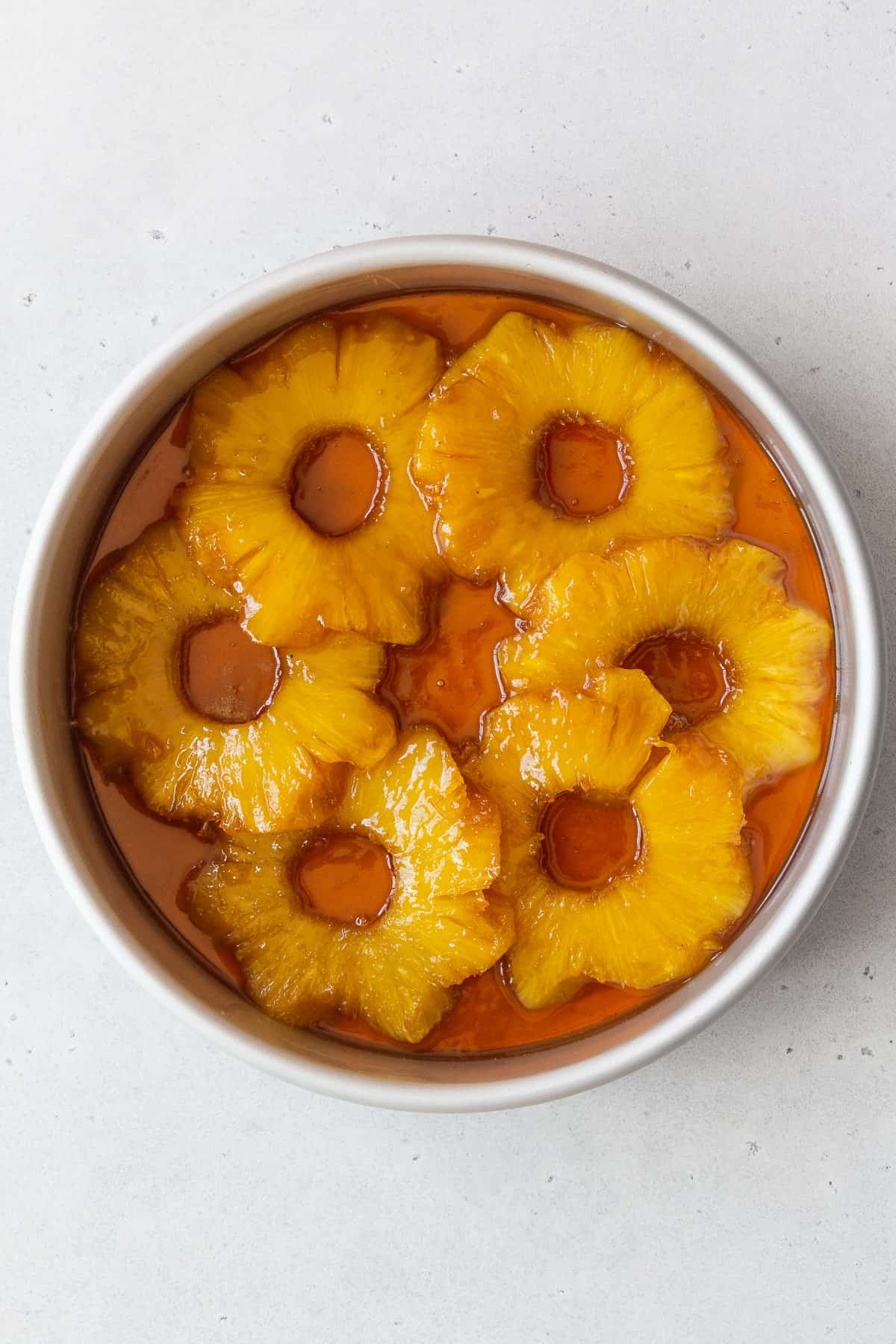
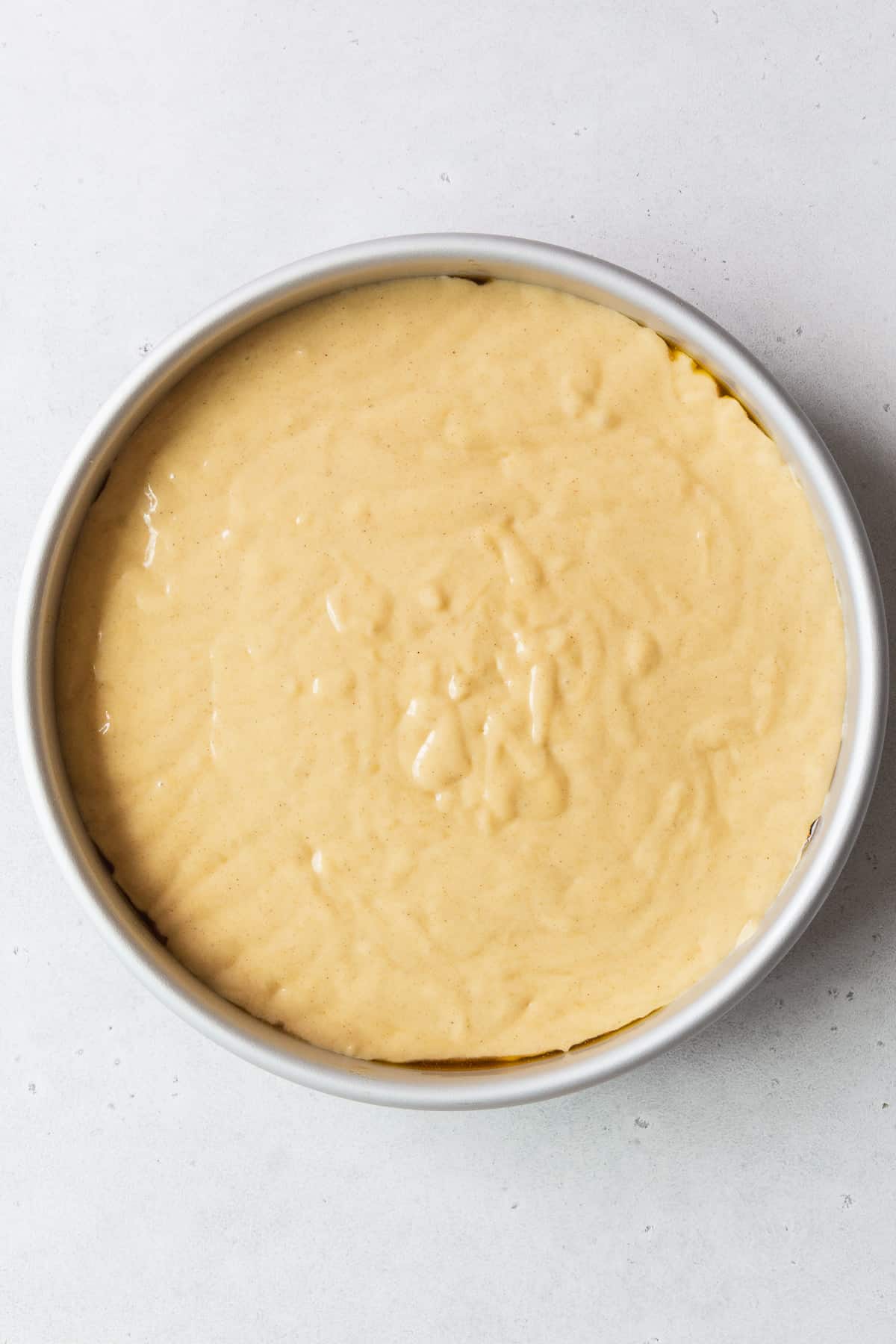
Step 10: Bake the cake for 40-43 minutes, or until a toothpick inserted into the center comes out clean. Let the cake cool for about 30 minutes before flipping it over onto a plate.


Recipe Success Tips
- Mix the Batter Thoroughly. Contrary to their traditional counterparts, gluten-free cake batters need to be over-mixed rather than under-mixed. Since there is no gluten in the flour, you will need to give the gluten-free pineapple upside down cake batter a few good extra stirs to help it develop structure.
- Let the Batter Rest. This allows the gluten-free flour to hydrate, creating that moist and delicate crumb.
- Carefully Pour the Cake Batter Over the Pineapples. The batter can push the pineapple rings around in the cake pan as you pour it in, so gently and slowly pouring it in is best.
- Cool the Cake Briefly Before Turning Out. This will allow the cake to release more easily from the pan.
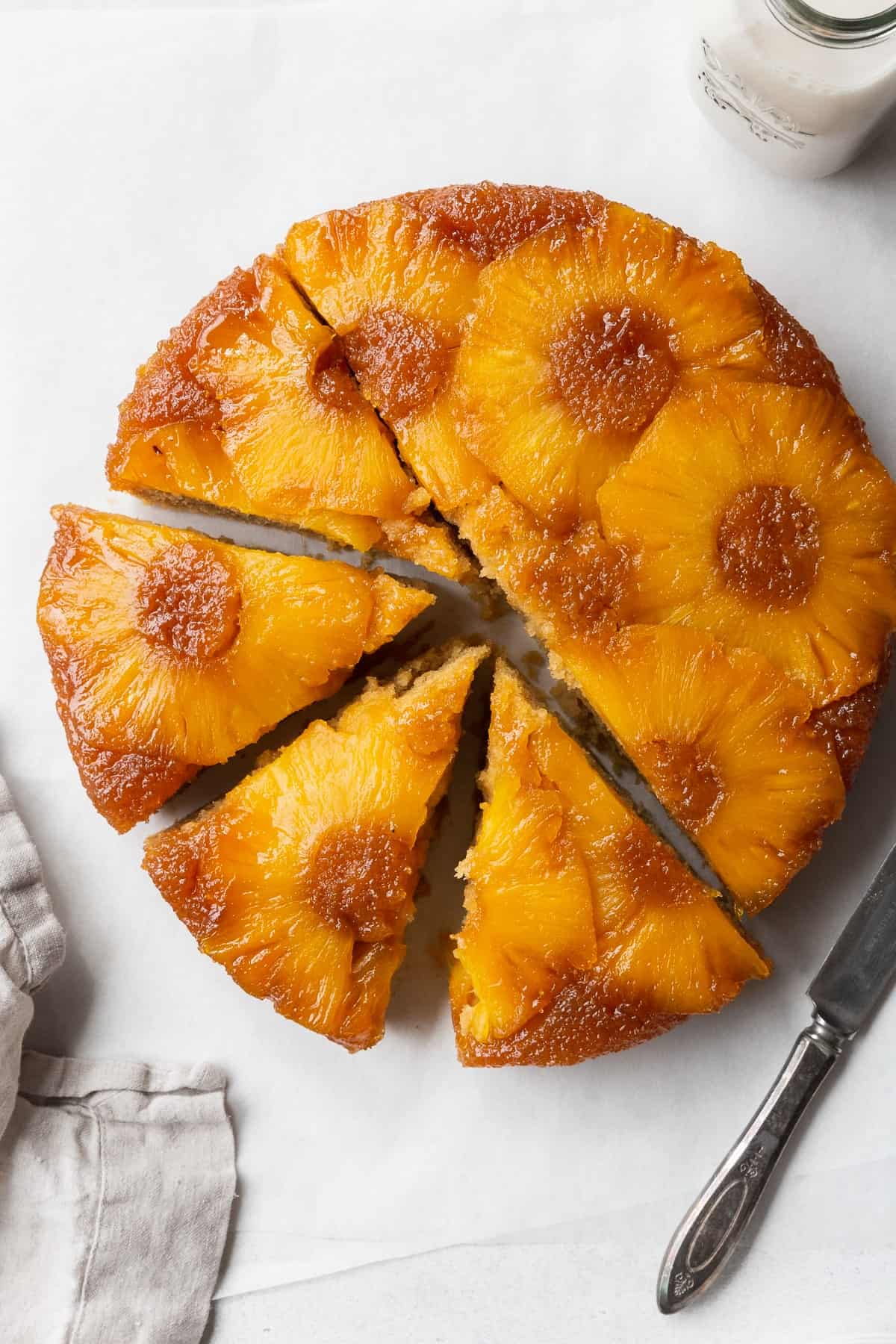
Storage Directions
- Refrigeration: Leftover gluten-free pineapple cake keeps covered in an airtight container in the refrigerator for 3-4 days.
- Freezing: The baked cake can also be frozen in a freezer-safe container for up to 3 months. Freeze the cake whole or wrap up individual slices in plastic wrap before placing them in the freezer-safe container.
- Defrosting: Individual pieces of pineapple cake will defrost at room temperature for 1 hour. Thaw the full cake covered in the refrigerator for 3-4 hours, or until entirely defrosted.
Dietary Adaptations
- This pineapple cake recipe is naturally vegetarian, nut-free, and gluten-free.
- To make dairy-free pineapple upside down cake, substitute mayonnaise for sour cream, vegan butter for unsalted butter, and non-dairy plant milk (like oat or almond milk) for the dairy milk.
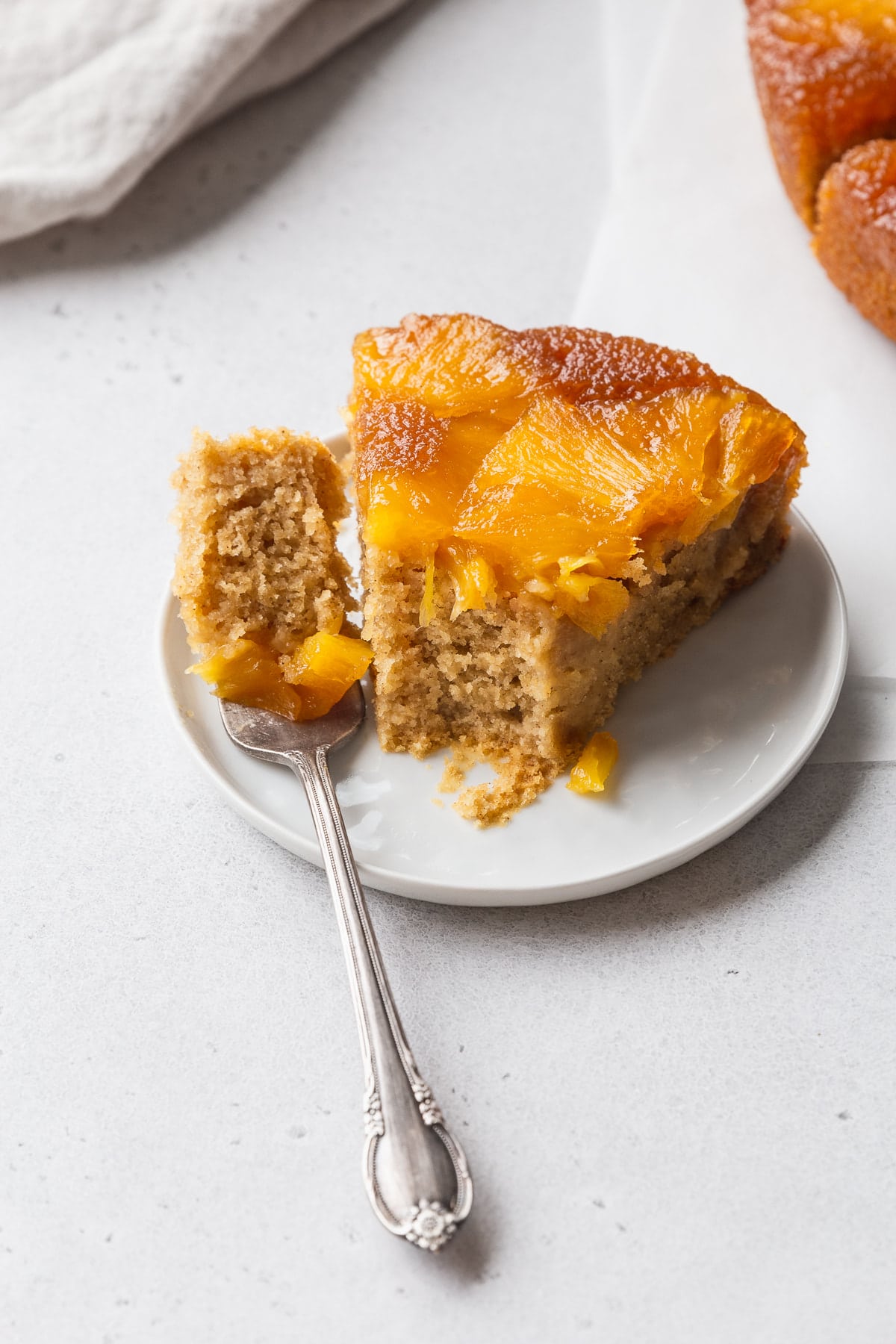
FAQs
Yes, fresh pineapple is gluten-free. It contains no wheat products or other sources of gluten as long as it did not share a cutting board with any foods that do. Almost all brands of canned pineapple are gluten-free as well, but you'll still want to double-check the ingredient label to confirm.
Your pineapple upside down cake might have fallen apart for a few reasons. The most common reasons are overmixing the batter, not adequately greasing the baking pan, and hitting or banging the pan to release the cake.
To prevent these issues, grease the cake pan well, and gently turn the cake upside down to release the cake. If you are making a gluten-free upside down cake, you do not need to worry about the cake texture being adversely affected by overmixing. Instead, I recommend giving it a few extra good stirs. Additionally, let the gluten-free cake batter rest for 30 minutes before pouring it into the cake pan, as this hydrates the flour, helping the cake's texture and consistency.
Yes, you do need to refrigerate pineapple upside down cake after it is baked to keep the pineapple from going bad. Cool the cake completely and cover the cake with a cake dome or plastic wrap and refrigerate for up to 4 days.
The best way to keep gluten-free cake mix from getting gummy is to use a gluten-free flour blend that contains xantham gum, let the cake batter rest for 30 minutes before baking, and stir the cake mix for an extra few stirs to help develop a delicate but still moist crumb.
Tools Needed to Make This Recipe
- Cutting Board
- Chef Knife
- Skillet
- Measuring Cups & Spoons
- Mixing Bowls
- Whisk
- Spatulas
- 9-Inch Round Baking
- Cooling Rack
More Gluten-Free Baking Recipes
Thanks so much for stopping by! I hope you loved this Gluten-Free Pineapple Upside Down Cake recipe as much as I do. For more mouth-watering dairy-free, gluten-free, and/or vegan dessert inspiration, make sure to follow me on Pinterest, Facebook, and Instagram. You can also get all of my newest content delivered straight to your inbox by signing up for my email newsletter — I promise not to spam you!
Recipe Card

Gluten-Free Pineapple Upside Down Cake
Ingredients
Pineapple Layer
- ¼ cup butter
- ¾ cup light brown sugar
- 1 small pineapple
- pinch of salt
Cake
- 1⅓ cups gluten-free 1-to-1 flour
- ⅓ cup cornstarch
- ½ teaspoon fine salt
- ½ teaspoon baking soda
- 2 teaspoons baking powder
- ½ teaspoons ground cinnamon
- ⅛ teaspoon ground cardamom
- ¾ cup granulated sugar
- ½ cup butter softened to room temperature
- 2 large eggs
- 2 teaspoons vanilla extract
- ⅓ cup sour cream
- ⅔ cup whole milk
Instructions
- Peel, core, and slice the pineapple into ½-inch thick rings. You'll need 6-7 slices. Reserve two tablespoons of the pineapple juice from the cutting board or, using a citrus press, squeeze juice from an extra slice.
- Add the butter, light brown sugar, salt, and pineapple juice to a skillet. Cook it over medium heat while stirring occasionally, or until it thickens slightly.
- Add the pineapple slices to the brown sugar mixture and cook for 10 minutes, flipping the pineapple halfway through. Take the skillet off the heat.
- In a bowl, whisk together the gluten-free flour, cornstarch, salt, baking soda, baking powder, cinnamon, cardamom, and granulated sugar until combined.
- Add the softened butter to the dry ingredients and, using your fingers or a pastry cutter, work the butter into the flour mixture until the mixture resembles coarse sand.
- In a separate bowl, whisk the eggs, sour cream, and vanilla together until combined. Add the wet mixture to the dry ingredient mixture and whisk to combine.
- While continuing to mix the batter, slowly pour in the milk until smooth and pourable. Cover the mixing bowl and let the batter rest for 30 minutes.
- While the batter rests, preheat the oven to 350°F (177°C) and grease the sides of a 9-inch round pan.
- Arrange the pineapple slices in the bottom of the pan. Pour all of the syrup on top. Carefully pour the cake batter over the pineapple, making sure not to move around the pineapple as you do. Smooth out the surface and bake the cake for 40-43 minutes, or until a toothpick inserted into the center comes out clean. Let the cake cool for about 30 minutes before flipping it over onto a plate.
Notes
- Refrigeration: Leftover pineapple cake keeps covered in an airtight container in the refrigerator for 3-4 days.
- Freezing: The baked cake can also be frozen in a freezer-safe container for up to 3 months. Freeze the cake whole or wrap up individual slices in plastic wrap before placing them in the freezer-safe container. Defrost individual pieces of pineapple cake at room temperature for 1 hour; thaw the full cake covered in the refrigerator for 3-4 hours, or until entirely defrosted.













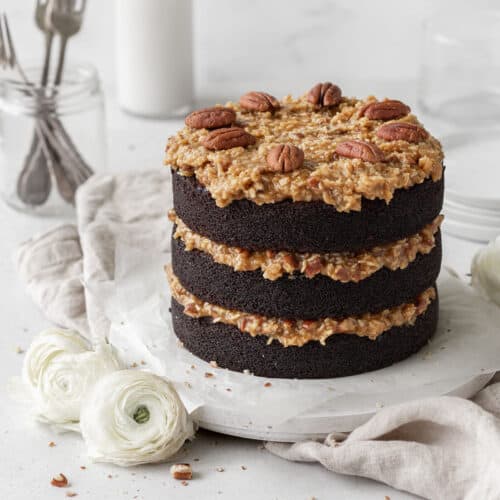
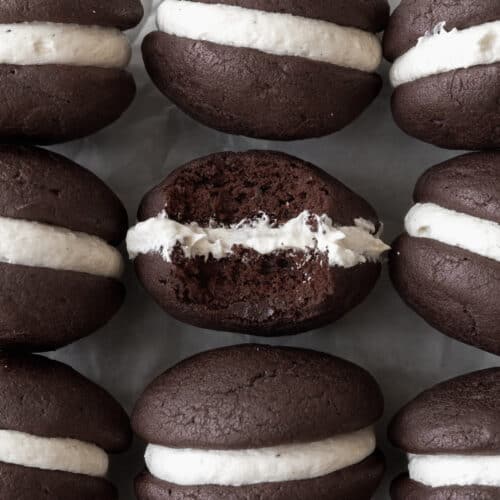

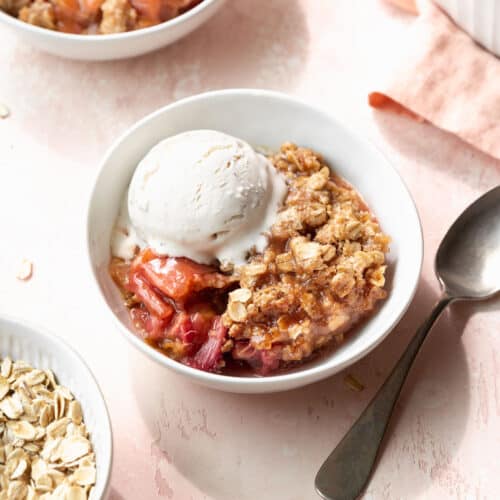

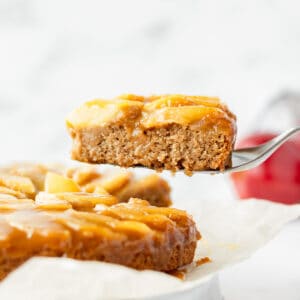




Leave a Reply